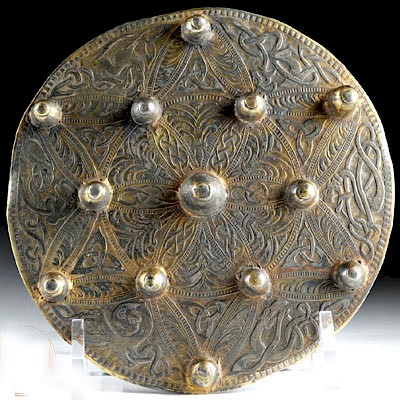Huge Indus Valley Polychrome Bowl with Lions
Lot 69C
About Seller
Artemis Gallery
686 S Taylor Ave, Ste 106
Louisville, CO 80027
United States
Selling antiquities, ancient and ethnographic art online since 1993, Artemis Gallery specializes in Classical Antiquities (Egyptian, Greek, Roman, Near Eastern), Asian, Pre-Columbian, African / Tribal / Oceanographic art. Our extensive inventory includes pottery, stone, metal, wood, glass and textil...Read more
Estimate:
$6,000 - $9,000
Absentee vs Live bid
Two ways to bid:
- Leave a max absentee bid and the platform will bid on your behalf up to your maximum bid during the live auction.
- Bid live during the auction and your bids will be submitted real-time to the auctioneer.
Bid Increments
| Price | Bid Increment |
|---|---|
| $0 | $25 |
| $300 | $50 |
| $1,000 | $100 |
| $2,000 | $250 |
| $5,000 | $500 |
| $10,000 | $1,000 |
| $20,000 | $2,500 |
| $50,000 | $5,000 |
| $100,000 | $10,000 |
| $200,000 | $20,000 |
About Auction
By Artemis Gallery
Jul 19, 2018
Set Reminder
2018-07-19 10:00:00
2018-07-19 10:00:00
America/New_York
Bidsquare
Bidsquare : Fine Antiquities/Ethnographic Art
https://www.bidsquare.com/auctions/artemis-gallery/fine-antiquities-ethnographic-art-3329
Featuring classical antiquities, ancient and ethnographic art from cultures encompassing the globe, plus fine art. Artemis Gallery info@artemisgallery.com
Featuring classical antiquities, ancient and ethnographic art from cultures encompassing the globe, plus fine art. Artemis Gallery info@artemisgallery.com
- Lot Description
Central Asia, Indus Valley, Harappan/Mohenjo-Daro civilization, ca. 2300 to 1900 BCE. An incredible, large example of a terracotta bowl painted with black outlined motifs of striding lions around its broad body. The bulbous vessel stands on a flat base and has an inwardly-curving mouth with an unpronounced rim. In classic Indus Valley style, behind the lions, the body of the jar is ringed by registers of abstract patterns and motifs. The motifs are painted on the buff beige surface of the vessel in red, sky-blue, and yellow. The copper sulfate used to create the blue color is in particular nice shape on this well-preserved example.
The lion motif is one of many animal representations favored in art created by the ancient people of the Indus Valley. It seems likely that the animal motifs had religious significance, and the majesty of lions - here shown with flowing, scale-like manes painted a fanciful blue against the yellow of the animals' bodies - would have struck this ancient people as powerful and fierce.
This piece has been tested using thermoluminescence (TL) and has been found to be ancient and of the period stated. A full report will accompany purchase.
Provenance: ex-private East Coast, USA collection; ex-Virginia & Col. Edward Dellinger collection, New York, USA, acquired 1970s
All items legal to buy/sell under U.S. Statute covering cultural patrimony Code 2600, CHAPTER 14, and are guaranteed to be as described or your money back.
A Certificate of Authenticity will accompany all winning bids.
We ship worldwide and handle all shipping in-house for your convenience.
#137115A few tiny chips from rim but otherwise intact and in excellent condition with well-preserved motifs and nice deposits on the surface.Condition
- Shipping Info
-
All shipping is handled in-house for your convenience. Your invoice from Artemis Gallery will include shipping calculation instructions. If in doubt, please inquire BEFORE bidding for estimated shipping costs for individual items.
-
- Buyer's Premium



 EUR
EUR CAD
CAD AUD
AUD GBP
GBP MXN
MXN HKD
HKD CNY
CNY MYR
MYR SEK
SEK SGD
SGD CHF
CHF THB
THB
















